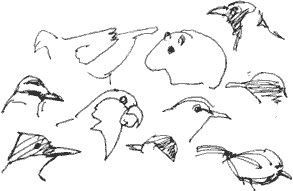
Suddenly Patagonia doesn't seem so remote and unattainable;
it's somewhere that ordinary people like you and I could go, find
a small hotel to stay in, get a meal in one of the local restaurants;
no big deal, you don't need tents, a fleet of Land Rovers, a local
guide, a team of divers and the latest high tech wildlife filming
gear. You only need to take the trouble to get out there to enjoy
this wild coast. And, of course, I'd take my sketchbook.
Philip tells us the way to drive your hire car along
the rough roads across the pampas without sinking into
the loose gravel, where to go to see the whales without taking
a boat ride from the beach and where to go birding in downtown
Beunos Aires (they've created a huge new wetland nature reserve
where the docks used to be).
I drew in the dark as Philip showed the slides.
I've forgotten most of the names of the birds but I did make a
note of one:
'This bird lives in the rushes and it looks like
a wren,' explained Philip, 'so they call it the wren-like
rushbird.' 